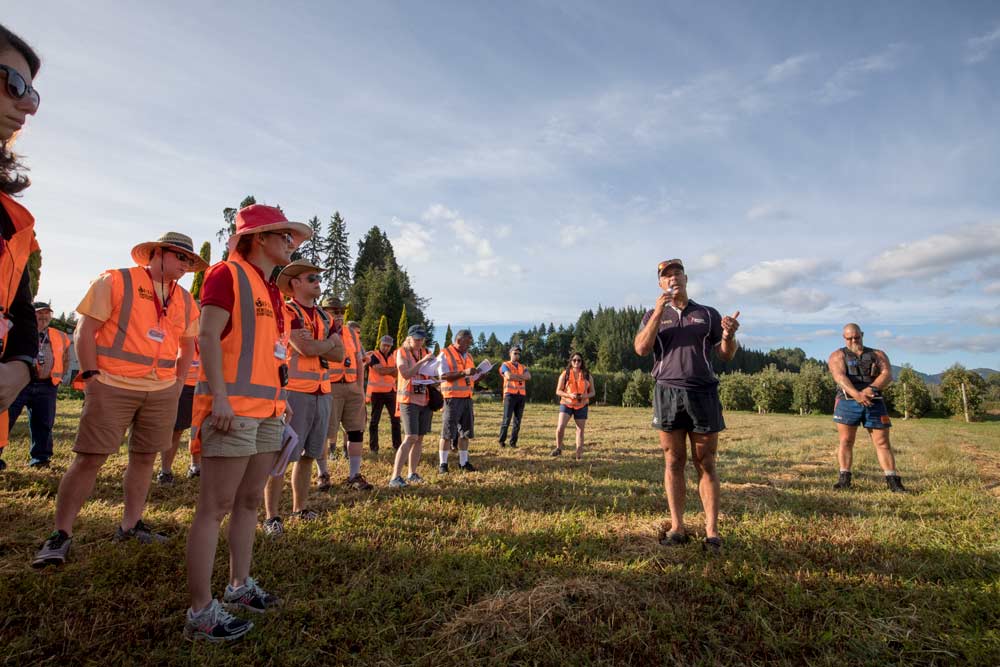
The International Fruit Tree Association visits Birdhurst Orchard in the Motueka Valley on February 18, 2018. (TJ Mullinax/Good Fruit Grower)
Editor’s note: This post has been updated to correct “flaring” to flowering,” a goof resulting from an American mishearing the Kiwi accent.
Attendees at the International Fruit Tree Association study tour had a visitor of their own in Nelson, New Zealand: Cyclone Gita, which brought heavy rains and high winds to the region.
The area at the north end of the country’s South Island features rolling green hills of timber and agricultural land — sheep farms, hop fields and orchards.
A number of growers suffered tree damage and flooding from the cyclone, but the storm didn’t prevent IFTA attendees from visiting several orchards in the area. Day one in Nelson included stops at four family orchards, one dating to the early 1900s.
At Birdhurst Orchard, a production partner of Golden Bay Fruit, brothers Kerry and Farran Wilkins have managed the transition from a tobacco and cattle business to apple and kiwifruit orchards. Today, they grow 500 acres of apples — Royal Gala, Jazz and Braeburn — and about 150 acres of Zespri Gold kiwifruit in the widest swath of the Motueka Valley.
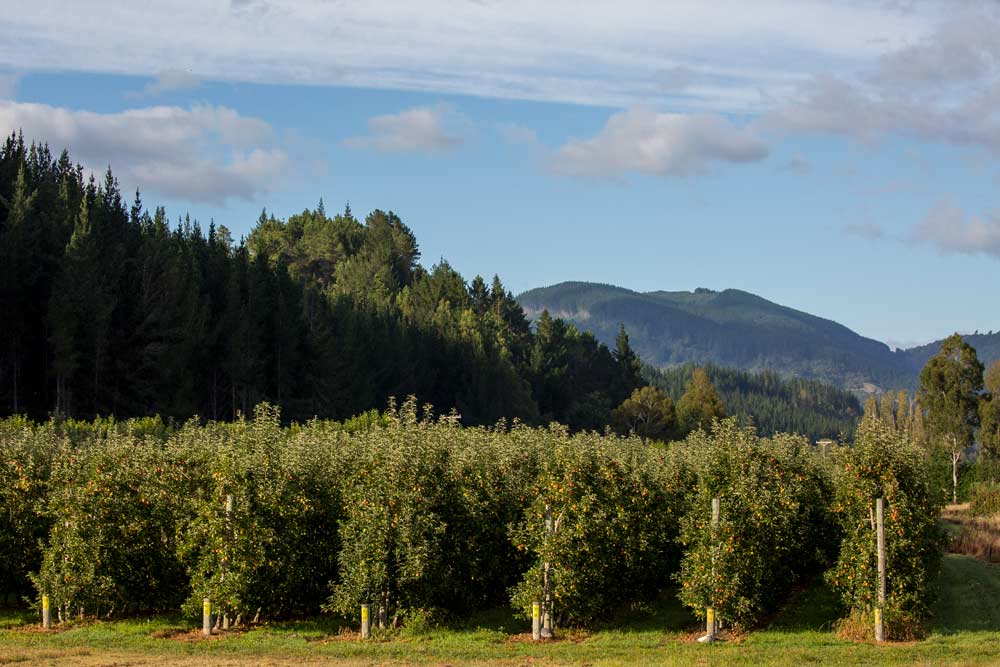
The IFTA Summer Tour visits Birdhurst Orchard in the Motueka Valley on February 18, 2018. (TJ Mullinax/Good Fruit Grower)
A Jazz block on Malling 9 rootstocks, planted at 2,000 trees per hectare (about 810 trees per acre) should produce close to 101 tonnes per hectare or about 101 bins per acre this year, up from just 97 tonnes in 2016 and 84.5 tonnes last year, orchard manager Aaron Cederman said.
That’s because they’ve worked hard to push trees to better harvest light. “By carrying most of the fruit on spurs, the flowering window is narrowing,” he said. “I’d rather have a long, skinny branch starting high and ending at my knees.”
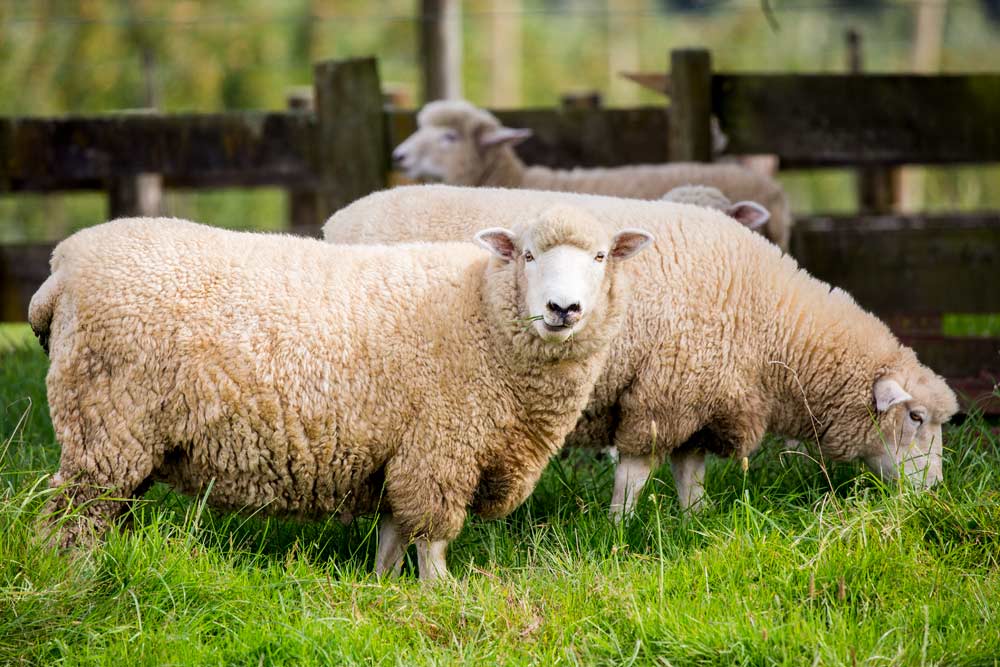
Sheep near Fairfield Orchards, New Zealand, on February 18, 2018. (TJ Mullinax/Good Fruit Grower)
About 25 people hand thin the block on instructions from a supervisor, and when they’re told to thin, they’re told why.
“If they know the reason they’re doing it and why they need to do it a certain way, we’ve gotten a more consistent result,” he said. “They self monitor, because a worker doesn’t want to pick that row that’s been thinned wrong.”
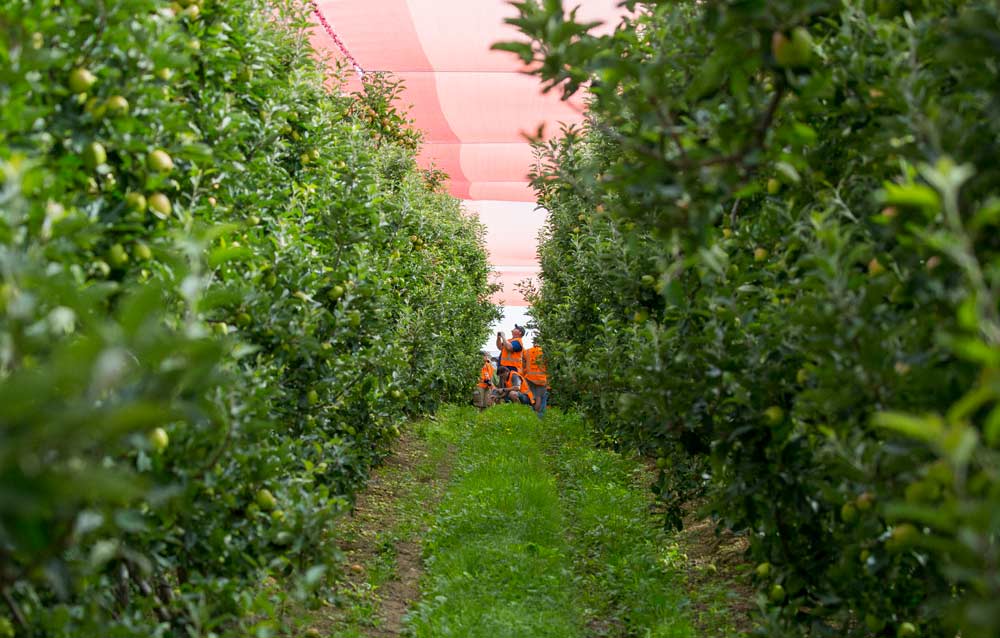
The IFTA tour of Fairfield Orchards’ covered Jazz block in the Motueka Valley on February 18, 2018. (TJ Mullinax/Good Fruit Grower)
Husband and wife Cherie and Aaron Drummond represent the third generation of Fairfield Orchards, growing mainly Royal Gala and Braeburn apples on about 1,000 acres. They’ve planted some of their first two-dimensional systems this year, largely controlled varieties, such as Jazz and Koru.
Their biggest issue: labor. They rely on Tongans to pick the fruit, and their workers were stuck at home by the cyclone and were expected to be late. Retaining skilled labor is also an issue, Aaron Drummond said. “We have a staff of 70 right now. They don’t want to put on a picking bag.”
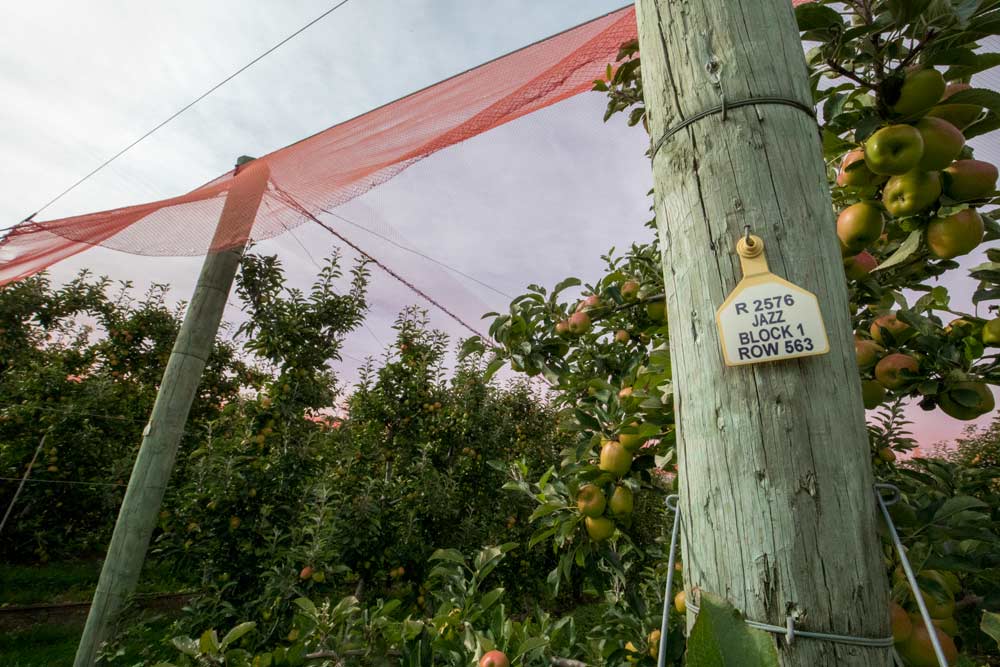
The IFTA tour of Fairfield Orchards’ covered Jazz block, in the Motueka Valley on February 18, 2018. (TJ Mullinax/Good Fruit Grower)
Drummond showed a 35 acre-block of Jazz, planted at about 1,000 trees per acre, mostly on M.9 and Geneva 202 rootstocks and some under netting. After a couple of seasonable hail storms over the past two or three years, they quickly installed netting over the rest.
Crop consultant Dean Rainham of AgFirst shared some of the strategies employed to improve size and yields in the block.
Previously, fruit would grow nicely until about Christmas, but wouldn’t finish off, he said. By returning to some basics — soil testing and tree nutrition monitoring — fruit size has increased 15 percent and yields have increased to a forecasted 90 tonnes per hectare this year.
“For every $10,000 spent, there’s a $160,000 profit,” he said. “Getting the foundations right really set this orchard up to getting a great result.”
A high-density planting of Envy apples on Pajam 2 rootstocks at Ian Palmer’s orchard might be 5 to 10 percent overcropped, primarily at the tops, Palmer said, but he plans to use reflective fabric to improve light penetration in the orchard.

The IFTA tour with Ian Palmer near Napier, New Zealand, on February 18, 2018. (TJ Mullinax/Good Fruit Grower)
Palmer is a former tobacco and kiwifruit farmer now focused on apples and a past chairman of the national growers association for pipfruit (apples and pears) in New Zealand. In addition to Envy, his variety mix includes Jazz, Ambrosia and Royal Gala.
“The industry here is always looking for the next big apple. I think the ones we have now will see us through for a while,” he said. “But like any new apple, we have to learn how to grow it well to make a success of it.”
The challenge with Envy is getting the apple to color, which requires proper pruning, thinning and light penetration for the tall spindle planting.
Palmer said he’s tried removing all the spurs from the insides of branches; he also tries to get initial fruit numbers from the tree early in the season.
“To me, growing apples is not about the trees, it’s about light. You don’t get the apple you want without the right light.”
Apples have been grown at Wairepo Orchards since the early 1900s. Today, the operation includes six orchards in the Mariri coastal area and surrounding Moutere Valley. Brothers Simon and Matthew Easton have bought out the rest of the family over the past five years and have been working to move the orchards to high-density plantings with a mix of varietals: Cox’s Orange, Fuji, Braeburn, Royal Gala, Jazz, Pink Lady, Southern Rose, Envy and Koru. Most are planted on G. 202, with some G. 210 and M.9. They’ve tried several spacings, some too close and some too far apart, eventually settling on 4-by-12 feet for any new plantings.
Their biggest struggle so far has been European canker, which required them to chop 8,000 trees in half or a third to cut it out, out of a 10,000-tree planting of Envy and Koru. “Every spare moment I had I walked another row,” Simon Easton said. It took time, he said, but “we’ve got the block back, now sitting at 80 to 90 tonnes in that block.”
“What we normally restructure in 10 years, we did in two,” he said.
_____
Days two and three in Nelson
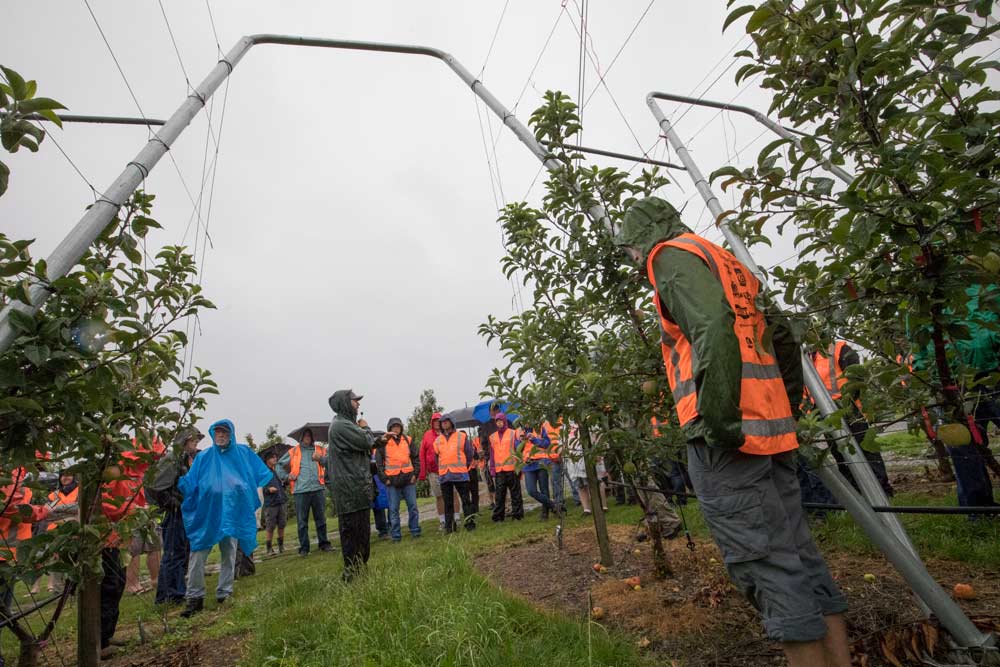
Undaunted by rain, the IFTA tour with Tristram Hoddy near Napier, New Zealand, on February 19, 2018. (TJ Mullinax/Good Fruit Grower)
Heavy rains and wind put a damper — literally — on IFTA explorations on the second day. The Hoddy family generously stood in a driving rain to talk about Vailima Orchards, which stretches across three properties in the Waimea Plains, a small but fertile area of low-lying land south of Nelson.
A trip to Washington state four years ago spurred son Tristram Hoddy to give V-trellis a go. A block of Ambrosia planted at about 3-by-11.5 feet should produce about 70 bins per acre this year.
Meanwhile, a Braeburn block on reflective fabric should yield about 140 bins per acre, so the goal of 120 to 130 bins per acre seems doable, dad Richard said. “We think we’re going down a reasonably good pathway,” he said.
The third day in Nelson featured just one stop, at Hoddy Fruit Co., where the storm left about a dozen apple rows leaning and knocked out power for six hours. Andrew Kininmonth, who shares management of the orchard with his father-in-law, Michael Hoddy, said they were thinking themselves “pretty lucky.”
The farm is moving more and more to 2D systems, which Kininmonth said relates to one thing: the need to harvest light.
“If we do our jobs, create windows, keep the windows open in the canopy, we do well,” he said. “We’re not apple growers. We’re actually farmers of light. We get light going on right, we’re actually bloody good farmers.”
Editor’s note: Look for additional reports on the IFTA New Zealand study tour in forthcoming issues of Good Fruit Grower.






Leave A Comment